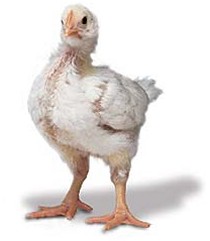IBD Symptoms and Lesions
Severity of symptoms and lesions is dependant on the virulence of the infective virus, type of bird (layer or meat-type) and the immune status of the infected bird. Acute and sub clinical IBD are distinguished.
Acute Clinical IBD
- Sudden onset of disease.
- Infected birds are depressed, have ruffled feathers, droopy appearance and may be seen pecking at the vent.
- Morbidity and mortality begins 3 days post infection, peaks and recedes in a period of 5 -7 days.
- Mortality may be negligible or as high as 90% in case of very virulent IBDV. The more common scenario is mortality of 10 – 20%.
- In the field situation the mortality in layer type birds is generally higher than in meat type birds.
- Birds that die are usually dehydrated (causing kidney lesions).
- Frequently petechial haemorrhages are present in the thigh and pectoral muscles.
- Haemorrhages and erosions may be present at the juncture of the proventriculus and gizzard.
- Bursal lesions are variable depending on the progress of the disease. Expected changes that may occur are tabulated below.

Variant IBDV strains do not cause as severe an inflammatory response. However severe bursal atrophy is characteristic and mortality is usually less than 5%.
Very virulent IBDV strains cause severe lesions in other lymphoid organs such as the thymus, caecal tonsils and spleen in addition to bursal lesions.


Bursas from Left to Right:
- Acute stage. Enlarged oedematous bursa
- 5 days post infection bursa returns to normal size.
May be haemorrhagic as in this specific bursa - 8 days post infection bursa atrophied and up to 1/8 of normal size
Subclinical IBD
- Subclinical IBD occurs when chickens are exposed to IBDV during the first two weeks post hatch and have sufficient maternal antibody at time of infection to prevent clinical disease but not viral replication in the bursa.
- Characterised by bursal atrophy, immunosuppression and resultant increased susceptibility to secondary infections (such as E. coli).
- No peak mortality as evidenced with clinical IBD.
- Secondary infections in broilers, mainly E. coli, result in a continuous above standard daily mortality and poorer feed conversions.
- Due to immunosuppression there can be a poor response to subsequent vaccinations.
Peer Reviewed by Dr J J (Sjaak) de Wit and William Baxendale.

